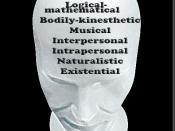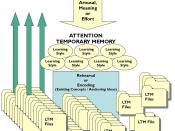Lewis 1
Katie Lewis
Professor Lee
English 102
How are you Smart?
Howard Gardner's Theory of Multiple Intelligences identifies the unique aptitude sets that make up each person, their capabilities, and their skillset. His theory reflects on the idea that human potential has a direct correlation with their learning preferences. Howard Gardner believes that "its not how smart you are that matters, what really counts is how you are smart" (Gardner). Gardner recognizes that people can be smart in non-traditional ways so he developed seven different intelligences to accurately represent an individual's strengths and capabilities
The seven intelligences are linguistic, logical, visual, kinesthetic, musical, intrapersonal, interpersonal, naturalist, and existential. The linguistic intelligence refers to those who have well-developed verbal skills, and logical intelligence represent those who excel in thinking conceptually and abstractly. Those with a visual intelligence have the ability to understand imagery and think abstract.
Kinesthetic intelligence are identified by their ability to handle objects skillfully. Musical intelligence are those who can produce and analyze rhythm and pitch. Those with an interpersonal intelligence are capable of recognizing and responding appropriately to the moods, motivations, and desires of others, while intrapersonal intelligence are those with the capability to be self-aware.
Due to the increasing pressure to raise test scores in schools, the place of arts within our educational system has become a controversial topic. I intend to defend the place of arts in our education system by answering the question: How does including arts in education allow each student to reach their full potential? To get a well rounded view of the issue I looked to three sources each with a different view on the topic. The first source stated that the benefits from arts education vary based on the type of art. The second source...


